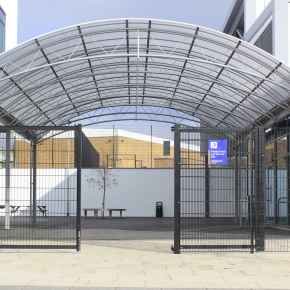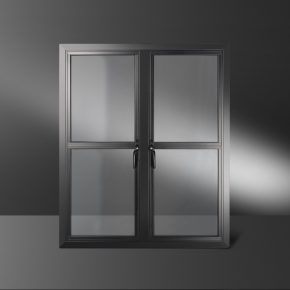
School security specifications aren’t changing, despite concerns
Jacksons Fencing, the leading perimeter security manufacturer in the UK, reveals architects’ insights on school safety in its report ‘Protecting the Future’. The report highlights substantial differences in views between architects and school management as well as outlining the common ground. It incorporates teachers’ perspectives on security matters.
– Schools have weak points in their perimeters and entrances, say one third of architects
– Multiple entry points are the greatest access control challenge affecting schools (90%)
– Three-quarters of school refurbishment specifications remain unchanged from the original ones (71%)
– Only 47% of architects know about LPS 1175
Almost two-thirds of architects know of schools being affected by problems with fencing and gates (60%). This is reflected in head teachers’ greatest concerns, unauthorised exits and entrances (30% and 25%). Most head teachers have commissioned new access solutions at least once (63%) and over three-quarters have had their perimeter inspected within the past five years (80%).
However, the majority of architects (71%) find that school security refurbishments use the original specifications with some value-engineering implying that these known these problems are clearly not being resolved.
Specification evasion
There are major concerns over cost and disruption, which are reflected in the number of schools keeping the same specifications despite security issues. Architects identify ‘budget’ as the greatest challenge when installing school fencing (84%), followed by restricted installation times (48%) and working where children are present (39%).
However, a perimeter’s cost is not the leading issue for school security. For teachers, performance is the highest priority (73%), followed closely by security ratings and accredited products (68%). These come ahead of lifetime (64%) and initial costs (59%).
Setting standards
Head teachers say that creating a positive learning environment (86%) and keeping the school community safe (82%) are the most important duties of their job. The role that school staff play in ensuring the safety of pupils has been reinforced by recent bomb threats sent to schools in the UK. One way of achieving protection is to ensure their security solutions meet industry standards.
A third of architects are seeing Secured by Design (SBD) and LPS 1175 standards increasingly specified (31%). A significant 95% are familiar with SBD. However, there are still improvements to be made: currently, under half of architects know about LPS 1175 (47%).
Head teachers may be concerned about the safety of their pupils, but it’s revealed that 39% don’t know where to go to find out more about school security and access control. They do, however, have some awareness of safety guidelines: half of school teachers, for example, are familiar with the recommended height for school fences. A similar portion know of the Royal Society for the Prevention of Accidents (RoSPA) guidelines, which mainly apply to playgrounds.
The inside perspective
Overall, architects’ views on school security are in line with teachers: 32% and 29% respectively acknowledge weak points in the perimeter. There is also agreement between both parties about which safety issues are afflicting schools the most: multiple entrances, having difficult to see areas and more than one building.
The report does show, however, that architects are more acutely aware of these problems than teachers: there is a 40% average difference between their responses to more probing questions. This disparity was especially marked where 72% of architects said that aging fencing is an issue, compared to 16% of teachers.
Cris Francis, Security Consultant at Jacksons Fencing, comments: “While there is a healthy level of agreement between architects and teachers on what the key school security issues are, our research reveals some concerning differences. Despite schools prioritising the performance of their fencing and gates, architects are up against stringent budgets that lead to maintaining outdated solutions or down specifying. Schools need to find a way of balancing cost with adequately ensuring children’s safety. Part of the problem might be that without a professional understanding of design and security, school staff can’t appreciate the impact of perimeter issues to the same extent as architects.
“Architects also have a greater awareness of safety standards and LPS 1175 certified products. By using their expertise to help schools choose the most appropriate solution for their specific risks and needs, they can help safeguard staff and students alike from future harm.”
Latest news

7th March 2025
ASSA ABLOY and Lorient Showcasing at the Fire Safety Event
ASSA ABLOY and Lorient are excited to announce their debut at the UK’s fastest-growing fire safety exhibition, the Fire Safety Event, taking place at the NEC, Birmingham, from 8 – 10 April 2025.
Posted in Access Control & Door Entry Systems, Architectural Ironmongery, Articles, Building Industry Events, Building Industry News, Building Products & Structures, Building Regulations & Accreditations, Building Services, Doors, Exhibitions and Conferences, Facility Management & Building Services, Health & Safety, Innovations & New Products, Posts, Restoration & Refurbishment, Retrofit & Renovation, Security and Fire Protection, Seminars
7th March 2025
Kent Company Wins Big With IronmongeryDirect’s TradeXtra Prize Draw
IronmongeryDirect, the UK’s leading online ironmongery specialist, is excited to announce the winner of its TradeXtra prize draw.
Posted in Access Control & Door Entry Systems, Architectural Ironmongery, Articles, Awards, Building Industry Events, Building Industry News, Building Products & Structures, Competitions, Doors, Innovations & New Products, Restoration & Refurbishment, Retrofit & Renovation, Security and Fire Protection, Videos
7th March 2025
Origin launches OW-70 Soho Window to revolutionise steel-look market
Origin, the UK’s leading manufacturer of premium aluminium windows and doors, has launched its groundbreaking OW-70 Soho Window.
Posted in Aluminium Products, Architectural Ironmongery, Articles, Building Industry News, Building Products & Structures, Building Systems, Doors, Glass, Glazing, Innovations & New Products, Restoration & Refurbishment, Retrofit & Renovation, Windows
6th March 2025
GEZE UK: Seeking Support at the National Fenestration Awards
GEZE UK is seeking support from industry professionals, clients and partners at the upcoming National Fenestration Awards, taking place on 25th October 2025, where the company is hoping to be shortlisted in five key categories.
Posted in Access Control & Door Entry Systems, Architectural Ironmongery, Articles, Awards, Building Industry Events, Building Industry News, Building Products & Structures, Building Services, Doors, Exhibitions and Conferences, Facility Management & Building Services, Health & Safety, Recruitment, Restoration & Refurbishment, Retrofit & Renovation, Security and Fire Protection, Windows
 Sign up:
Sign up: